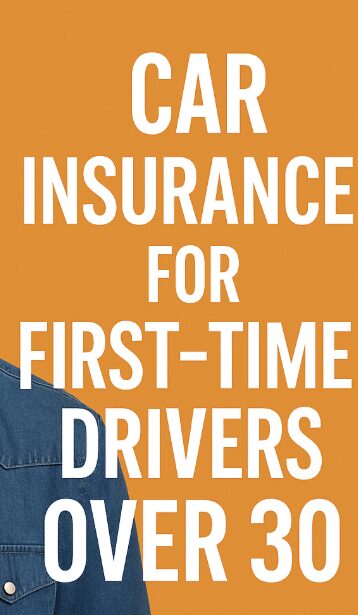When people think of first-time drivers, they usually imagine teenagers getting their learner’s permit. But what about adults who get their driver’s license for the first time after 30? Whether you delayed driving due to city living, financial reasons, or personal preference, you’re not alone—and you deserve fair, affordable car insurance just like anyone else.
Unfortunately, the car insurance industry often doesn’t know what to do with first-time drivers over 30. Many insurers lump you in with teens in terms of risk—even though you’re more mature, financially stable, and far less likely to be reckless on the road. This post breaks down what to expect, how to get the best rates, and which companies are more open to working with late-blooming drivers.

Why First-Time Drivers Over 30 Face Unique Insurance Challenges
Car insurance pricing is all about risk prediction. Insurers analyze your age, location, driving history, and more to predict how likely you are to make a claim. But if you’ve never had a license before—or never had an insurance policy—they have little data to work with. This can flag you as a “new driver,” even if you’re 35, 40, or 50.
As a result:
You might get quoted similar rates to 17–19-year-old drivers
Some insurers might flat-out refuse to offer coverage
You may be excluded from bundling discounts due to lack of history
The good news is that with some strategy, you can still find competitive rates and avoid being penalized just for starting late.
What Factors Still Work in Your Favor
Even if you’re a first-time driver, being over 30 gives you several advantages:
Age alone lowers risk: Statistically, drivers over 30 are less likely to engage in risky behavior
Stable lifestyle: Owning a home, being married, or holding a steady job can all reduce premiums
Financial reliability: Better credit scores can lead to better rates (in most U.S. states)
You likely won’t be driving for social status: You’re not drag-racing to impress classmates anymore
These factors help differentiate you from teens in the eyes of smarter insurance providers.
Best Insurance Companies for First-Time Drivers Over 30
While some major insurers might give you high quotes or limited coverage, others are more flexible and modern in their underwriting approach. These companies are more likely to view you fairly:
GEICO: Known for reasonable first-time driver policies and discounts for good credit or defensive driving courses
Progressive: Offers an online quote tool that considers life stage, not just driving history
Nationwide: Strong customer support and flexible policies for drivers without a record
Root Insurance: Uses app-based driving tracking rather than judging you solely on history
Esurance: Streamlined online process and reasonable first-time driver pricing
You can start by comparing quotes using tools like this insurance comparison platform or this popular car insurance calculator.
How to Reduce Your Insurance Premium as a New Adult Driver
Even if you get hit with a higher quote at first, there are ways to reduce your cost fast:
Take a defensive driving course: Many insurers offer a discount for completing an approved course
Buy a modest car: Avoid sports cars or high-theft vehicles; aim for safe, used sedans or SUVs
Raise your deductible: A higher deductible can significantly lower your monthly premium
Bundle with renters or home insurance: If you have another policy, combine them to save
Drive safely for 6–12 months: After a year with no claims, you’ll be eligible for lower renewal rates
Also, make sure your insurance company allows you to opt in to safe driving tracking programs. Apps like Snapshot (Progressive) or DriveEasy (GEICO) can reward you with real data—not assumptions.
How Much Should You Expect to Pay?
Rates vary widely by state and provider, but here’s a ballpark range for first-time drivers over 30:
Minimum coverage: $600 to $1,200/year
Full coverage: $1,200 to $2,400/year
Again, this assumes no driving history. If you’ve been licensed but never insured, your quote may fall lower. Use free quote tools like this one to compare across insurers.
Avoid These Common Mistakes
Not shopping around: One quote doesn’t reflect the full market. Compare at least 3–5 providers
Assuming your age is enough: Age helps, but lack of history still counts—find insurers that weigh both
Delaying coverage: Driving uninsured is illegal and risky. Even if you’re not using your car daily, maintain coverage
Consider getting a policy even before buying a car. Some insurers offer non-owner policies to build history.
Driving Confidence Begins with Fair Coverage
Just because you started driving later doesn’t mean you should be penalized. You’re not a teenager anymore, and your insurance policy should reflect that. With a bit of research, smart comparisons, and safe driving, you can find an affordable policy that treats you fairly.
To start comparing providers that specialize in unusual driver profiles, check out tools like The Zebra or Policygenius and find coverage that works for you without overpaying.
